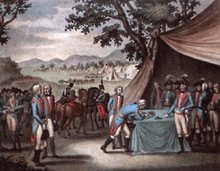Treaty of La Jaunaye
The Treaty of La Jaunaye was a peace accord signed by François de Charette and Charles Sapinaud de La Rairie, on behalf of the leaders of the Vendée rebels and chouans, and by Albert Ruelle on behalf of the National Convention on 17 February 1795 at the manor of La Jaunaye, at Saint-Sébastien-sur-Loire, near Nantes. The treaty brought an end to major hostilities in the War in the Vendée - the rebels recognised the French Republic and in return received assurances on freedom of religion, the abolition of conscription and the right to arm a militia.[1]

Background
In May 1794, Turreau, commander of the Armée de l'Ouest, was recalled from his post, and the practice of infernal columns was brought to an end. After the Thermidorian reaction, in August 1794 Hoche was placed in charge of the Army of the Coasts of Brest and in October 1794, Jean Baptiste Canclaux was given command of the Army of the West. Both generals favoured conciliation with the rebels, and contacts were established with the insurgents through the intercession of Mme de Gasnier-Chambon, a creole from Saint-Domingue who knew Mlle de Charette, sister of the rebel general.[2]
Negotiations
These contacts led to a meeting at Saint-Sébastien, near Nantes, a commune held by the insurgents. Led by Canclaux and Charette, negotiations lasted from 12–17 February. The final agreement granted a number of concession to the rebels - an amnesty, a guarantee of religious freedom, and exemption from military service while retaining the right to keep their arms. All their goods were restored to them, and they were compensated for anything sold or burned, as well as reimbursed for their assignats. These undertakings applied even to individuals listed as émigrés. The Republican armies also agreed to withdraw from the rebel-held areas.
On behalf of the French Republic, the treaty was signed by Ruelle, Delaunay, Pomme, Brue, Lofficial, Chaillon, Bollet, Jary, Menuau, Dornier and Morrisson. On behalf of the rebels it was signed by Charette, Fleuriot, Couëtus, Cormatin, de Bruc, Guérin the older, Caillaud, de Foignard, Goguet, Lepinay, Sauvaget, Baudry, Guérin the younger, Solilhac, Béjarry, de Bruc the younger, Prudhomme, Rejeau, de la Roberie, Rousseau, Bossard the younger and the older son of Auvinet.[3] The rebel leader Jean-Nicolas Stofflet, who did not arrive at Nantes until 18 February, refused to sign the treaty, and only eventually did so on 2 May at Saint-Florent-le-Vieil.
Treaty outcomes
The treaty did not bring a complete cessation of hostilities, as several of its signatories took up arms again in the months which followed. Charette broke the treaty on 24 June 1795, having recently learned of the death of Louis XVII on 8 June. He was pursued by government forces, arrested on 2 March 1796 at Saint-Sulpice-le-Verdon and executed by firing squad at Nantes on 29 March.[4] Sapinaud resorted to arms once again in October 1795. but surrendered again in January 1796 at Nantes. Stofflet, for his part, rebelled again in January 1796, on the orders of the comte d'Artois, who appointed him lieutenant-general. He was quickly taken and executed at Angers on 25 February 1796.[5] Despite these setbacks, life in the area previously controlled by the Vendée rebels gradually returned to normal in 1796 and 1797.
Location

Two neighbouring manors, la Grande Jaunaie and la Petite Jaunaie, existed in 1795 and still stand today. Sources are unclear which of them was the location for the negotiations and the agreement. Today the older building, la Petite Jaunaie, is a private house in the rue Charette de la Contrie. La Grande Jaunaie, built in the 18th century by Claude de Monti, a nobleman from Nantes after he bought the estate, is today a children's home in the rue de la Jaunaie.[6] It is likely though that the conference was held in la Grande Jaunaie and the signing ceremony took place in a tent, closer to la Petite Jaunaie.[7]
References
- Chronicle of the French Revolution, Longman 1989 p.469
- J Crétineau-Joly, Histoire de la Vendee Militaire, Vol.2 Gosselin, 1844 p.286
- Patrick Huchet, Georges Cadoudal et les Chouans, Éditions Ouest-France, 1997, p. 193-194
- George J. Hill, The Story of the War in La Vendée and the Little Chouannerie, Burns and Lambert, 1856 pp.222-227
- Jean Julien Michel Savary, Guerres des Vendéens et des Chouans contre la République Française, Baudouin, 1827 p.191
- http://www.ouest-france.fr/pays-de-la-loire/saint-sebastien-sur-loire-44230/quest-devenu-le-manoir-de-la-grande-jaunaie-3229415 accessed 13/04/2017
- Entre Sèvre et Loire, publication de la Mairie de Saint-Sébastien, 2000, p.85